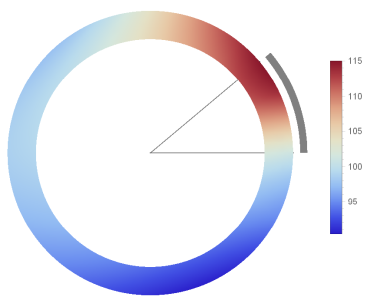To solve the problem, we can apply FEM using explicit Euler in time. So that there were no messages, we organized a weak leak across the border.
Needs["NDSolve`FEM`"]; t1 = 2; \[CapitalDelta]\[Phi] =
40/180 Pi ; r1 = 0.161; r2 = 0.201; \[Lambda] = 1/2;
f[x_] := Piecewise[{{50 , 0 <= x <= \[CapitalDelta]\[Phi]}, {0,
True}}]; mesh = ImplicitRegion[r1^2 <= x^2 + y^2 <= r2^2, {x, y}];
t0 = 1/20; n = 40;
U[0][x_, y_] := 100;
Do[U[t] =
NDSolveValue[(u[x, y] - U[t - t0][x, y])/
t0 - \[Lambda] Laplacian[u[x, y], {x, y}] + (x D[u[x, y], y] -
y D[u[x, y], x]) - f[ArcTan[x, y]] + 0.025 (u[x, y] - 20) ==
NeumannValue[10^-9 u[x, y], True], u, {x, y} \[Element] mesh,
Method -> {"FiniteElement", InterpolationOrder -> {u -> 2},
"MeshOptions" -> {"MaxCellMeasure" -> 0.001,
"MeshOrder" -> 2}}];, {t, t0, n t0, t0}]
Table[DensityPlot[Evaluate[U[t][x, y]], {x, y} \[Element] mesh,
PlotLegends -> Automatic, PlotLabel -> Row[{"t = ", t*1.}],
ColorFunction -> ColorData["ThermometerColors"], PlotPoints -> 100,
Frame -> False, ColorFunctionScaling -> True], {t, 10 t0, n*t0,10 t0}]
 For comparison, we used the 1D model, given the absence of gradients along
For comparison, we used the 1D model, given the absence of gradients along r. We see that the data is consistent with FEM.
With[{r = (r1 + r2)/2},
U1 = NDSolveValue[{Derivative[1, 0][u][t, \[CurlyPhi]] +
Derivative[0, 1][u][
t, \[CurlyPhi]] == \[Lambda] D[
u[t, \[CurlyPhi]], {\[CurlyPhi], 2}]/r^2 + f[\[CurlyPhi]] -
0.025 (u[t, \[CurlyPhi]] - 20), u[0, \[CurlyPhi]] == 100,
u[t, 0] == u[t, 2 Pi]}, u, {\[CurlyPhi], 0, 2 Pi}, {t, 0, t1},
Method -> {"MethodOfLines",
"SpatialDiscretization" -> {"TensorProductGrid",
"MinPoints" -> 200, "MaxPoints" -> 200,
"DifferenceOrder" -> 4}}]]
Table[DensityPlot[
Evaluate[U1[t, ArcTan[x, y]]], {x, y} \[Element] mesh,
PlotLegends -> Automatic, PlotLabel -> Row[{"t = ", t*1.}],
ColorFunction -> ColorData["ThermometerColors"], PlotPoints -> 100,
Frame -> False, ColorFunctionScaling -> True], {t, 10 t0, n*t0,
10 t0}]
 Also, in version 12, we can use FEM and time dependency. The result completely coincides with that obtained using explicit Euler:
Also, in version 12, we can use FEM and time dependency. The result completely coincides with that obtained using explicit Euler:
U12 = NDSolveValue[{D[u[t, x, y],
t] - \[Lambda] Laplacian[
u[t, x, y], {x, y}] + (x D[u[t, x, y], y] -
y D[u[t, x, y], x]) - f[ArcTan[x, y]] +
0.025 (u[t, x, y] - 20) == NeumannValue[10^-9 u[t, x, y], True],
u[0, x, y] == 100}, u, {t, 0, t1}, {x, y} \[Element] mesh,
Method -> {"FiniteElement",
"MeshOptions" -> {"MaxCellMeasure" -> 0.001}}];
Table[DensityPlot[Evaluate[U12[t, x, y]], {x, y} \[Element] mesh,
PlotLegends -> Automatic, PlotLabel -> Row[{"t = ", t*1.}],
ColorFunction -> ColorData["ThermometerColors"], PlotPoints -> 100,
Frame -> False, ColorFunctionScaling -> True, PlotRange -> All], {t,
10 t0, n*t0, 10 t0}]

The 2D "MethodOfLines" with periodic boundary conditions in polar coordinates gives a solution that does not have physical meaning. For example, the code below has no messages (unlike the one suggested by Ulrich Neumann)
U2 = NDSolveValue[{Derivative[1, 0, 0][u][t, r, \[CurlyPhi]] +
Derivative[0, 0, 1][u][t,
r, \[CurlyPhi]] == \[Lambda] Laplacian[
u[t, r, \[CurlyPhi]], {r, \[CurlyPhi]}, "Polar"] +
f[\[CurlyPhi]] - 0.025 (u[t, r, \[CurlyPhi]] - 20),
u[0, r, \[CurlyPhi]] == 100, u[t, r, 0] == u[t, r, 2 Pi],
Derivative[0, 1, 0][u][t, r1, \[CurlyPhi]] == 0,
Derivative[0, 1, 0][u][t, r2, \[CurlyPhi]] == 0},
u, {r, r1, r2}, {\[CurlyPhi], 0, 2 Pi}, {t, 0, t1},
Method -> {"MethodOfLines",
"SpatialDiscretization" -> {"TensorProductGrid",
"MinPoints" -> 40, "MaxPoints" -> 100,
"DifferenceOrder" -> "Pseudospectral"}}]
Compare solution U2 and solution U1 (1D "MethodOfLines"). We see that in 2D the heat flux at the boundary $\phi =0=2\pi$ has a gap, which is devoid of physical meaning.
Plot[{U2[2, (r1 + r2)/2, phi], U1[2, phi]}, {phi, 0, 2 Pi}]

We add the condition of equality of heat fluxes at the boundary $2\pi=\phi =0$. In this case, the solution has the form
U2 = NDSolveValue[{Derivative[1, 0, 0][u][t, r, \[CurlyPhi]] +
Derivative[0, 0, 1][u][t,
r, \[CurlyPhi]] == \[Lambda] Laplacian[
u[t, r, \[CurlyPhi]], {r, \[CurlyPhi]}, "Polar"] +
f[\[CurlyPhi]] - 0.025 (u[t, r, \[CurlyPhi]] - 20),
u[0, r, \[CurlyPhi]] == 100, u[t, r, 0] == u[t, r, 2 Pi],
Derivative[0, 0, 1][u][t, r, 0] ==
Derivative[0, 0, 1][u][t, r, 2 Pi],
Derivative[0, 1, 0][u][t, r1, \[CurlyPhi]] == 0,
Derivative[0, 1, 0][u][t, r2, \[CurlyPhi]] == 0},
u, {r, r1, r2}, {\[CurlyPhi], 0, 2 Pi}, {t, 0, t1},
Method -> {"MethodOfLines",
"SpatialDiscretization" -> {"TensorProductGrid",
"MinPoints" -> 40, "MaxPoints" -> 100,
"DifferenceOrder" -> "Pseudospectral"}}]
Now we see an even greater difference between solutions of the equation obtained using 2D "MethodOfLines" and FEM (1D and FEM coincide on this scale).
Plot[{U2[2, (r1 + r2)/2, phi], U1[2, phi],
U12[2, Cos[phi] (r1 + r2)/2, Sin[phi] (r1 + r2)/2]}, {phi, 0, 2 Pi},
PlotRange -> All, PlotLegends -> {"2D", "1D", "2D FEM"},
AxesLabel -> {"\[CurlyPhi]", "u"}]








Derivative[0, 1, 0][u][t, r1, \[CurlyPhi]] == 0, Derivative[0, 1, 0][u][t, r2, \[CurlyPhi]] == 0$\endgroup$TensorPorductGridbyFiniteElementNDSolve doesn't evaluate. Or would you suggest another way? $\endgroup$